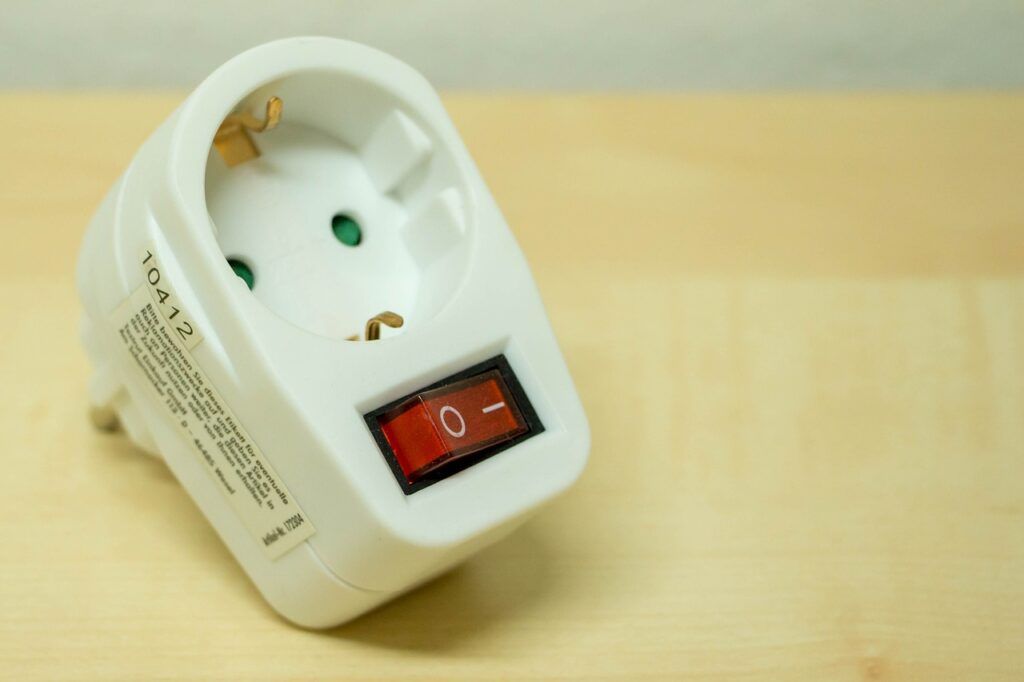

We know when you’re getting ready to travel, you want to think about the things you’ll be doing, the sights you’ll be seeing and the memories you’ll be making. The last things you want to think about are logistical issues like which travel adapter to buy and whether you need to worry about the voltage standard in the country you’re visiting.
Unfortunately, these issues do really matter. You don’t want to find yourself in a situation where your phone is running out of battery, and you take out your charger only to realise you can’t actually plug it in because you didn’t pack the right travel adapter. Here, we’ll cover everything you need to know to avoid this kind of situation.

What is a travel adapter plug?
In the most basic terms, a travel adapter will allow an electronic device from one country to be plugged into the wall outlets in another country. A UK to EU adapter, for example, allows you to plug a UK device into the adapter, and the adapter can be plugged into an EU plug socket, allowing you to use the UK device in Europe.
It should be noted that a travel adapter on its own won’t convert the voltage. Instead, it is purely designed to allow plugs from one country to connect to plug sockets in another. This is not a problem if the two countries use the same voltage standard, which is true for the UK and the EU, as they both use 230V.
However, it will be an issue when travelling between two countries with different voltage standards. The US, for instance, uses 120V plug sockets, while the UK uses 230V. In these cases, a voltage converter or voltage transformer will also be required. Don’t worry, though, as we’ll get into that a little bit later. We promise it isn’t quite as confusing as it sounds.
Will I need a travel adapter for my trip?
If you’re travelling away from your home country, you’ll need to check what plug type is used in the country you’re visiting. Then you’ll need to compare this to the plug type you use in your own country. If the two types are the same, you won’t need to invest in a travel adapter. If they are different, you’ll usually need to buy an adapter.
Using our previous example, the standard plug used in the UK is Type G, which features three rectangular pins arranged in a triangle pattern. The standard plug for most EU countries is Type C, which features two round pins. To use UK devices in these European countries, you’ll need to buy a European plug adapter that you can plug a UK device into.
Voltage converters and transformers: a brief summary
We don’t want to bombard you with too much information, so all you really need to know about voltage is that it’s a measurement of the force of an electric current. Rather unhelpfully for all of us, the voltage standard is different all over the world. For instance, the UK uses 230V, while the United States uses 120v. On the other hand, Mexico uses 127V, while China uses 220V, and so on.
This has an impact on the plans you need to make when travelling abroad because your electronic devices are likely designed to accommodate the voltage standard for the country you live in. If you have a 230V appliance or device and try to plug it into a 120V outlet, the device will not work, or it might, but at a reduced capacity. If you have a 120V device and attempt to plug it into a higher voltage 230V outlet,
you risk damaging the device’s internal components or could even cause a fire.
To put this in real-world terms, you can’t safely plug a typical US device designed for 120V into an EU plug socket. This is because the EU has a higher voltage standard than the US. You are also unable to plug an EU device into a US plug socket because the US has a lower voltage standard than the UK standard of 230V.
The exception to this rule is that some appliances have a voltage range instead. An example would be 100-240V, and this would mean the device will work in any country with a voltage standard between 100 and 240V.
Voltage converters and voltage transformers are devices that allow you to circumvent the issues of using devices in a country with a different voltage standard. These devices work by changing the voltage of the power source.
How do I know if I need a voltage converter or transformer?
Before travelling, you need to know the voltage rating for your devices and the voltage standard for the country you are visiting. If they do not match, you’ll usually need a voltage converter or transformer. So what is the difference between a converter and a transformer, and how do you know which one you need for your devices?
The simple way to think of the difference between converters and transformers is that converters are designed for devices that are used in short bursts, such as hair clippers, electric razors and hair dryers.
Transformers are larger and more complex devices. These are used with electronics that are operated over a longer period. Examples of this would include a desktop computer or a printer.
A growing number of electronic devices and appliances are dual voltage or worldwide voltage. These are the aforementioned devices that display the voltage as a range rather than as a single number. They shouldn’t require either a converter or a transformer in order to be safely used in a country with a different voltage standard.
European Plug Adapter
A European plug adapter, or EU travel adapter, will be suitable for use in most European countries, including France, Germany, Spain, Italy, Greece, the Netherlands and Portugal. Some of the most notable exceptions include the UK, the Republic of Ireland, Cyprus and Malta, as none of these countries utilises the Type C plug that’s used throughout the rest of Europe.
A device that is designed for the Type G plug type, like a UK device, could not usually be connected to a typical France or Italy plug socket. Yet, a UK to EU adapter would allow UK devices to be plugged into the adapter, which would then fit into the Type C plug socket, allowing these devices to be used throughout most of Europe.
It should also be noted that Type C devices from Europe can fit into Type E, F, J, K and N outlets. These outlets are often used instead of Type C outlets. For instance, plugs in Turkey are Type C, but they usually go into a Type F outlet.
United States and Canada Adapter
The United States and Canada both use Type A and Type B plugs and outlets. A Type A plug will feature two parallel pins, while a Type B plug also includes a grounding pin that’s positioned centrally underneath the two parallel pins. A Canada plug will work in the United States — and vice versa — but devices from elsewhere may require a travel adapter.
When travelling to these countries, you should pack a three-to-two-prong socket plug adapter, allowing your appliances and devices to be used, even if a Type B wall outlet is not available. Both Canada and the US use the 120V voltage standard, so you’ll need a converter or transformer if your devices are designed for a higher voltage. Without using a converter or transformer, your devices may not work or
may work at reduced capacity.
The Mexico plug type is also the same, although the voltage standard in Mexico is slightly higher, at 127V. The standard Japan plug is also Type A or B, but the voltage standard in Japan is lower, at 100V.
Travel adapters in other countries
There are various other countries around the world with their own plug types. The Australia plug standard is Type I, while India uses Types C, D and M. Several African countries, like Nigeria and Kenya, use the UK-style Type G. Other countries using this plug type include Qatar and Saudi Arabia. The Morocco plug type will be either C or E.
Plugs in Thailand are more complicated. The official Thai standards are Type C and Type O, but American-style Type A and Type B plugs can also be used in many places. However, this compatibility is gradually being phased out. Now that you have an understanding of the type of travel adapter you may need, it’s time to find your ideal destination and book an adventure to remember.



